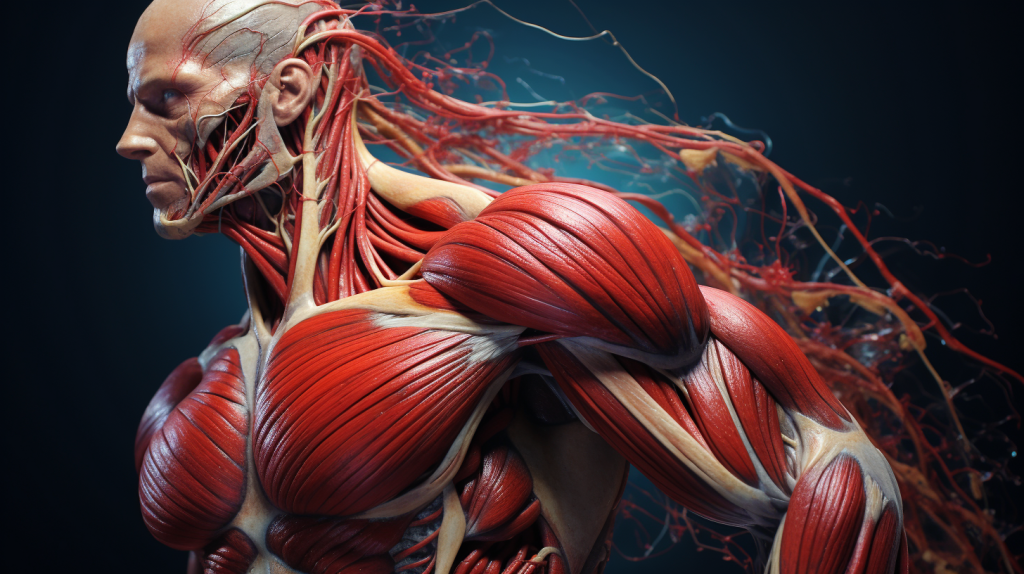As described earlier, the human movement system is composed of three systems. The skeleton, the nervous system, and the muscular system. One of the functions of the skeleton is to serve as an attachment point for muscles. The nervous system is the control center for the generation of movements. Muscles contract, manipulating the bones of our body and creating movement.
The function of the muscular system
Muscle tissue possesses unique properties. It is excitable (responds to stimuli), can contract, is elastic, and stretchable. The primary function of muscle tissue is to produce body movement. Additionally, muscles are constantly involved in maintaining posture; without realizing it, you remain upright or standing. When you are cold, muscles contract, causing you to shiver, generating heat to maintain body temperature.
Types of muscle tissue
There are three different types of muscle tissues.
Skeletal muscle
Skeletal muscle is the largest group among muscle tissues. We can control these independently, enabling movement. These are the “normal” types in our body. For example, the biceps, quadriceps, etc.
Smooth muscle
Smooth muscle tissue is found in the walls of our organs; these facilitate contractions, such as moving food through our digestive tract.
Cardiac muscle
Cardiac muscle tissue is only found in our heart. Like smooth muscle tissue, we cannot control these voluntarily.
Tendons attach muscles to bones. Tendons are similar to bands, as they also have poor blood supply, which leads to poor recovery from tears or minor injuries.
Composition of muscles
The smallest structural and functional unit of a muscle is the sarcomere. It is actually composed of many of these small structures, and these are the parts that can contract, thereby becoming smaller and enabling movement. Before a muscle contraction can occur, it must be activated by motor neurons. These neurons carry impulses from the central nervous system to the muscles. A motor neuron that controls various fibers is also called a motor unit. There are large and small motor units. Many muscles are composed of many of these motor units. When a motor unit is stimulated, all fibers contract together, which is also called the all-or-none response. The muscles responsible for moving your eyes have only 10 to 20 fibers in each motor unit. This allows for very precise control and movement of the eyes. The gastrocnemius, or calf muscle, can have between 2000 and 3000 fibers per motor unit. These movements are more powerful and do not require fine coordination.
Types of muscle fibers
There are different types of muscle fibers:
- Slow Fibers (Type 1, Slow Oxidative)
- Intermediate Fibers (Type ΙΙa, Fast Aerobic)
- Fast Fibers (Type ΙΙb, Fast Anaerobic)
Slow Fibers are also called red fibers because they have a good blood supply. They are smaller than type 2 fibers and are less powerful. However, these fibers can continue to contract, making them essentially fatigue-resistant.
Fast Fibers are also called white fibers because they have a poorer blood supply. They are larger and can produce more force than type 1 fibers, but they fatigue much faster. Intermediate fibers are pinkish and resemble fast fibers more than slow fibers. However, they can contract for longer periods, providing greater resistance to fatigue.
Achieving muscle growth
It is interesting to know that muscles are differently composed. Many back muscles have a higher proportion of Slow Fibers because they continuously contract to keep us upright. Only Fast Fibers are present in our hands because they need to react and contract quickly. How this is precisely structured varies from person to person and is largely genetically determined. Long-distance runners will have many more Slow Fibers than Fast Fibers, whereas for sprinters, this is reversed. The amount of Intermediate Fibers can be adjusted through training. With prolonged training, Fast Fibers can acquire properties of Intermediate Fibers. It can also work the other way around, although this is slightly more difficult in practice, as Intermediate Fibers may start to resemble Fast Fibers. Training can thus lead to improvement in both strength and endurance; it depends on how you train.
Through training, fibers can become thicker, resulting in muscle growth (hypertrophy). This does not mean that you get more fibers (hyperplasia). When muscle fibers become smaller due to, for example, a long period of not training or due to illness, this is called muscle atrophy.
The composition of muscles varies among individuals and is genetically determined. If you are naturally a sprinter, you will have more fast-twitch fibers than someone who easily runs long distances. A sprinter could potentially improve in longer distances through endurance training. Conversely, a long-distance runner could also become faster in sprinting, although this process is a bit more challenging.

